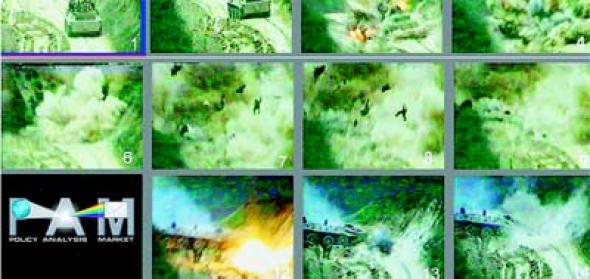Betting on Terror
David Mandl reports on the Policy Analysis Market (PAM), yet another perverse Pentagon brainchild
The Bush II administration, with an agenda that makes Ronald Reagan look like a Naderite, and a collective attitude that is a perverse reinterpretation of the situationists’ injunction, ‘Be reasonable – demand the impossible’, isn’t easily cowed by whining opposition liberals. So all eyes were riveted to the Pentagon when negative publicity on an arcane Defence Department programme caused the project’s plug to be yanked within minutes, its website to be wiped clean, and its mastermind John Poindexter – a convicted felon who had previously enjoyed unwavering support from the White House – to be sent packing.
The project, the Policy Analysis Market, was to be a ‘market in the future of the Middle East’ – a government-funded futures market allowing traders to make financial bets on the likelihood of various political and economic events in the region. The general idea wasn’t controversial or new: the Iowa Electronic Markets have allowed traders to bet on the outcome of presidential elections for years, for example. With PAM, though, the administration’s mistake was underestimating the Pavlovian power of the word terrorism, which they’d been using so successfully themselves to further their crusade against constitutional rights. Catching wind of the details of the new project (which was due to become operational on October 1, 2003), two Democratic senators pounced and, in a press conference, called it ‘a federal betting parlour on atrocities and terrorism.’ This was undeniably true to a degree. One of the selling points of PAM was its potential use to ‘manage risk’ – that is, hedge your other investments by taking into account the possibility of a major disruption to business (and in the Middle East, what might that be?). The PAM website itself (which has fortunately been preserved at [http://www.ratical.org/ratville/CAH/linkscopy/PAM/ ]) even listed the overthrow of the Jordanian monarchy as an example of the kinds of developments PAM traders might bet on.
It was equally obvious that someone planning a terrorist attack could add insult to injury by placing an insider’s bet on PAM and making a couple of million easy bucks on the side. In fact, the added financial incentive might actually encourage someone to commit a terrorist act. The icing on the cake was the claim that PAM traders were guaranteed anonymity, ruling out the possibility that PAM bets by terrorists could even be used to track the perpetrators down. (This claim was admittedly nearly worthless, coming as it was from the same people that had dreamt up the über-surveillance program TIPS – the Total Information Awareness Project.)
Nevertheless, the PAM idea had its fans, mostly among the monomaniacs who believe that Markets are the answer to every conceivable problem. Since futures markets are used to predict the weather, crop yields, and magazine sales, their argument went, why not harness that power (the brainpower of thousands of sophisticated traders with big money at stake!) to forecast the likelihood of geopolitical events? One response might be: Because they are wrong so often. The financial slaughter of the past few years (in which plenty of ‘smart money’ was lost alongside all the neophyte day-trader wealth), and Wall Street’s tainted-research scandals, should have shaken out the last remaining believers in perfectly efficient markets, but some beliefs die hard. Further, being mistaken about GE’s fourth-quarter profits is one thing, but being mistaken about an impending nuclear attack is quite another – and based on the speculations of a bunch of futures traders, no less!
Maybe PAM was an implicit acknowledgement of the now-open secret that the intelligence agencies’ intelligence is no good. Or maybe it was simply the kind of amusing plaything that a tech freak with a free-market bent will naturally come up with when given enough resources and money (the public’s money, that is). But while PAM might have been a hare-brained idea, it would have been small beer compared to any number of other activities being engaged in in the financial world. With my tax dollars, though? I don’t think so.
Above >A US soldier comments on the images found on the Ussyorktown.com website [http://www.ussyorktown.com/yorktown/stennis.htm ] ‘Contributed by a former squadron member and CCT guy. Job satisfaction. From pilot aboard USS John C. Stennis. He was the strike element lead on this attack, and received these pictures as a "thank you" from the US Army controllers on the ground. It is an excellent example of a joint combined arms operation. A Taliban al-Qaida armoured vehicle (ex-Russian USSR Bmp) with troops embarked and riding on top, targeted by forward air controllers (FAC's) of the US Army, 4th Special Operations Group. A flight of two Navy F-14 Tomcats are called in by the US Army FAC's and strike the vehicle nearly simultaneously with GRU-16 laser guided bombs. As a bonus, there is a nice secondary explosion in the middle of the road, towards the end of the set. Actual File Footage: US Army 10 December 2001 0730 (Note: this is also attributed to USSR War against Afghanistan photos of USSR Personnel Carrier going over Afghani mine)’ Above, inset >PAM logo from PAM website [http://www.ratical.org/ratville/CAH/linkscopy/PAM/ ]
David Mandl <dmandl AT panix.com > is a writer, photographer, and DJ at WFMU-FM in New York City
Mute Books Orders
For Mute Books distribution contact Anagram Books
contact@anagrambooks.com
For online purchases visit anagrambooks.com








